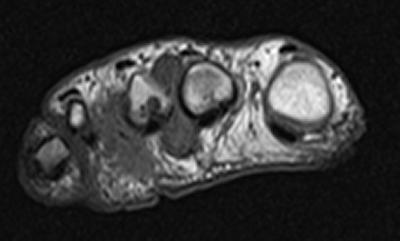‘Walking on marbles’ could be a thing of the past for arthritis patients

Researchers at the University of Southampton are to undertake a new stage of a study aimed at improving the health and mobility of those suffering from the common complaint of ‘walking on marbles’ associated with Rheumatoid Arthritis (RA) in the feet.
RA is the second most common form of arthritis in the UK, affecting almost 600,000 people, which results in the destruction of joints around the body caused by inflammation.
Forefeet often contain some of the first joints to be affected and those with the condition often say that they feel like they are ‘walking on marbles’. Mostly, people have thought that this was due to walking on foot joints that are affected by the RA.
The Health Sciences’ FeeTURA study however, developed new ways of assessing the forefeet through the use of diagnostic ultrasound and magnetic resonance imaging techniques. From this work, the team discovered that some of the swellings and associated feeling of ‘walking on marbles’ were related to inflamed bursae (a fluid-filled sac usually found in areas subject to friction) that had developed underneath the forefoot joints. These inflamed bursae were rarely detected by clinical examination.
The exact cause of the inflamed bursae is not known and a cure is yet to be found, however, the team is now looking at identifying inflammatory and mechanical markers to find the best ways of treating this complication in people suffering with RA. They will evaluate foot health treatments, such as targeted steroid injections, as well as medical management through the use of new drugs (called biologics).

This new stage of the study will be funded through a partnership between Solent NHS Trust and the Faculty of Health Sciences at the University of Southampton and supported by a National Institute for Health Research (NIHR) clinical academic fellowship.
During the first stage of the study, which took place between 2006 and 2009, researchers at the University of Southampton developed a technique to better evaluate the forefeet and diagnose the ‘marbles’ using diagnostic ultrasound. Participants’ who were assessed at the NIHR Wellcome Trust Clinical Research Facility (WTCRF), based at Southampton General Hospital, returned for re-assessment in the second stage of the study which discovered the changes that had occurred in the condition.
A third stage used an MRI scan to visualise the anatomical structures and ‘marbles’ more clearly in the forefeet (see photo) and resulted in researchers developing the first ever atlas to categorise the swellings originally identified in stage one.
Led by senior lecturer for Advanced Clinical and Expert Practice, Dr Catherine Bowen, this new stage of the treatment study will be carried out by clinical academic researcher, Lindsey Hooper, who recently won a prestigious special award from Wessex HIEC for the previously completed MRI work.
Dr Bowen comments: “Although more common in the UK than leukaemia and multiple sclerosis, awareness of the severity of rheumatoid arthritis is limited.
“Our linked study aims to significantly improve the lives of those affected by the condition in their forefeet, reducing the severity of the symptoms including pain, inflammation, poor sleep, fatigue and depression, and therefore helping improve their mobility and wellbeing.”
Lindsey Hooper adds: “This is an amazing opportunity to be involved in a study that is potentially life-changing for the many people suffering from this progressively debilitating condition.
“As I am maintaining my clinical role as a rheumatology podiatrist whilst also completing the research it means the findings can be fed directly back into clinical practice, so that local patients receive the most up-to-date care options.”